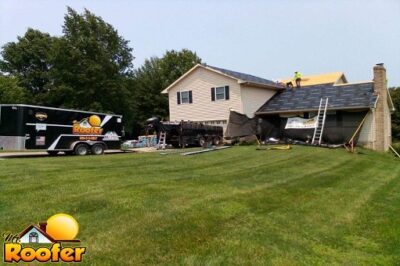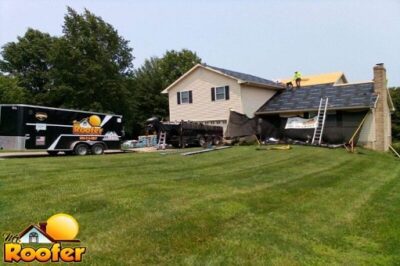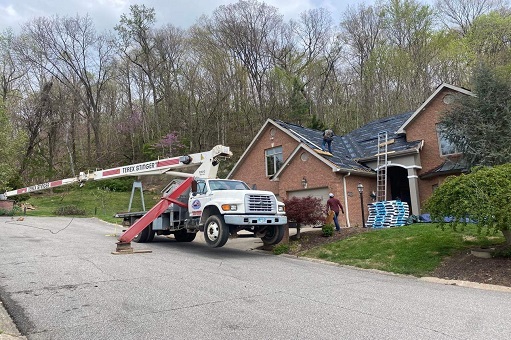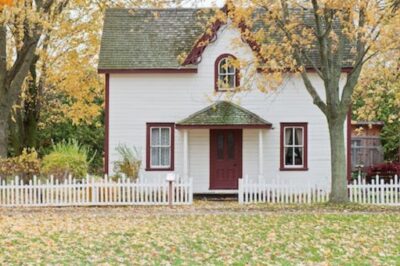Have you ever considered the importance of keeping that flat roof tip-top shape? I mean, it’s the shield that stands between your cozy abode and the unpredictable elements, right?
But let’s face it, those elements don’t play nice – rain, sun, snow, you name it, they all gang up on your roof. That’s where the superhero skill of flat roof repair swoops in to save the day.
So, get ready for a deep dive into the world of flat roof fixes. We’re talking about those typical troubles that frown flat roofs – ponding water, pesky cracks, and sneaky leaks.
Grab your tool belt; we’ll break down the must-have gear and materials for this DIY adventure. And guess what?
I’ve got the ultimate step-by-step process to guide you through patching, sealing, and even giving your roof a watertight armor.
Whether you’re a homeowner with a roof-shaped headache or just itching to get your hands dirty with DIY magic, this guide is your golden ticket. Together, we’ll crack the code to a longer-lasting flat roof that’ll keep you cozy and dry for years.
Ready?
Let’s dive in!
Common Flat Roof Problems
Let’s talk about the typical suspects that flat roofs have to deal with:
Ponding Water: Have you ever noticed those annoying puddles that won’t quit after it rains?
That’s ponding water, like a party invitation for roof damage.
Cracks Galore
Cracks can pop up like unexpected guests at a party. They’re tiny at first but can turn into full-blown issues if left unattended.
Leaky Leaks
Ah, leaks – the unwelcome surprise that shows up at the worst possible time. They can drip, damage, and dampen your spirits (not to mention your interiors).
Buckle up because we’re about to tackle these problems head-on and give you the scoop on how to put these issues in their place. Let’s dive into the nitty-gritty of flat roof repairs!
Inspection and Assessment Of Your Flat Roof
Here’s how you can Sherlock Holmes your way through a thorough inspection:
Eagle Eyes Required
It’s time to channel your inner detective. Look for any signs of trouble – cracks, blisters, or spots that don’t look right.
Follow the Water
Remember, water is a telltale snitch. Trace the water path during rain and see where it’s sneaking in. That’s your starting point for investigation.
Weak Spots Hunt
Some spots on your roof might be weaker than others. These are like the Achilles’ heels of your roof. Check seams, edges, and areas around equipment.
Document and Click
Don’t forget your trusty camera. Document what you find – it’ll come in handy later if you need professional help or want to keep track of changes.
Tools and Materials Used For A Flat Roof Repair
Here’s your toolkit for conquering those roof woes:
1. Safety First
Safety Harness
This is your lifeline. It keeps you tethered while you work on the roof, preventing any unexpected gravity-defying stunts.
Gloves and Safety Glasses
Protect those precious hands and eyes from debris, sharp edges, and flying bits.
2. Inspection and Repair
Roofing Shovel
Perfect for clearing debris and getting to the root of problems.
Putty Knife
Your go-to for scraping away old sealant and preparing surfaces for patching.
Utility Knife
A trusty sidekick for slicing and dicing materials with precision.
Patch Material (EPDM, TPO, etc.)
The show’s star. You’ll use it to fill in cracks and cover trouble spots.
Sealant: Your liquid armor. Sealants keep water out and can be a lifesaver for preventing leaks.
Roof Coating
Think of this as sunscreen for your roof. It protects against UV rays and keeps your roof looking younger for longer.
Measurement and Marking:
Tape Measure
Measure twice, cut once. You’ll use this to make sure everything lines up just right.
Chalk Line: It’s like a laser beam marking straight lines on your roof. Super handy for keeping things tidy.
3. Accessories
Ladder
Your trusty steed for ascending to roof level. Safety note: Make sure it’s sturdy and secure.
Bucket and Rags
Cleanliness is next to roof-godliness. Keep these nearby for quick cleanups.
Remember, these tools and materials have a specific role in the grand repair scheme. From scraping away old gunk to applying patches and giving your roof an armor of protection, your toolkit will be your best buddy. So, gear up and make your roof the neighborhood envy!
Step-by-Step Repair Process of Your Flat roof
It’s time to get hands-on and bring that roof back to its prime. Here’s the lowdown on how to tackle flat roof repair services like a pro:
Step 1: Preparation
Safety first! Put on your safety harness, gloves, and glasses.
Clear the roof of debris – you need a clean slate to work with.
Secure your ladder and create a safe work area.
Step 2: Identifying the Issue
Start your detective work: Look for cracks, blisters, and problem areas.
Track where water is sneaking in during rain – this is your target zone.
Step 3: Cleaning and Surface Prep
Use your roofing shovel to clear debris from around the problem area.
Grab your putty knife and scrape away old sealant, ensuring a clean surface.
Step 4: Patch Application
Cut your patch material to fit the problem area, with a bit extra for good measure.
Apply adhesive as needed and press the patch into place. Make sure it’s snug and secure.
Step 5: Sealing and Waterproofing
It’s time for the sealant! Apply a generous amount around the edges of the patch.
Smooth it out with your putty knife to create a watertight seal.
Step 6: Final Inspections
Take a step back and admire your work. Does everything look smooth and sealed?
Run your fingers along the edges to make sure the patch is securely in place.
Step 7: Preventive Maintenance
Regularly inspect your roof to catch issues before they become monsters.
Monitor drainage and clear any debris that could clog things up.
There you have it – a step-by-step guide to whip that roof into shape. Patience is essential, and attention to detail pays off big time. By the time you’re done, you’ll have transformed your roof from a troublemaker to a fortress against the elements.
Important Preventive Maintenance For Your Flat Roof
Okay, so you’ve conquered those roof troubles like a champ.
Now, let’s talk about how to keep that victory dance going for the long haul with some preventive maintenance:
1. Regular Inspections
Schedule regular check-ups for your roof. A quick visual once in a while can catch issues before they escalate.
2. Clear Drainage
Keep those gutters and drains clean and free from debris. A clogged drain can turn into a mini swimming pool on your roof.
3. Prompt Action
If you spot even a tiny issue, don’t procrastinate. Minor problems can turn into big headaches faster than you think.
4. Trim Those Trees
Overhanging branches might look picturesque, but they can drop leaves and twigs and even cause damage during storms.
5. Snow Removal
Clear snow buildup to prevent excessive weight and potential damage if you’re in a snowy area.
6. Document Changes
Take photos during your inspections and compare them over time. This can help you catch changes that might need attention.
7. Professional Checks
Consider getting a professional inspection every few years. They can catch things you might have missed.
Remember, the goal here is to be proactive rather than reactive. Taking these small steps can save you big headaches down the line. Think of it as giving your roof extra love to keep it tall and strong.
Professional Help and DIY Considerations
Let’s get honest about when to put on the DIY hat and when to call in the pros. Here’s the scoop:
When to DIY?
Small Repairs:
Minor cracks, small patches – these are DIY-friendly. With the right tools and materials, you got this.
Confidence Level:
If you’re a seasoned DIYer and feel comfortable on the roof, go for it. Just remember safety first!
Preventive Maintenance:
Regular inspections and minor touch-ups? DIY away! It’s a great way to keep your roof in top shape.
When to Call the Pros?
Extensive Damage
If the issue seems beyond your skills – like extensive leaks or significant structural damage – it’s time to phone a professional.
Safety Concerns
Roof work can be dangerous. If you’re not comfortable with heights or the proper safety measures, don’t risk it.
Warranty Worries
Some roofing materials have warranties that might be voided if not repaired by a professional.
Time Crunch
If you’re in a hurry or don’t have the time to learn the ins and outs of roof repair, let the experts handle it.
What is the Cost of Flat Roof Repair?
The cost of flat roof repair widely depends on several factors, including the extent of the damage, the type of repair needed, the roofing material, your location, and whether you choose to repair yourself or hire a professional.
Here’s a general overview:
DIY Repair Costs
If you’re repairing yourself, the costs will primarily include the materials needed, such as patching, sealants, and tools.
DIY repairs are typically more cost-effective than hiring professionals, as you’re not paying for labor.
Professional Repair Costs
Hiring a professional will involve labor costs in addition to the materials used.
The cost is based on the complexity of the repair. Minor repairs might cost a few hundred dollars, while major repairs or roof replacement services could cost several thousand dollars.
Location plays a role in pricing. Repair costs are higher in areas with higher living expenses and contractor rates.
It’s recommended to get multiple quotes from reputable roofing professionals in your area to get a more accurate estimate for your specific repair needs. Keep in mind that investing in quality repairs now can save you from more expensive issues down the line.
Preventive Maintenance
Preventive maintenance is like giving your flat roof a superhero shield against future problems. Here’s how to keep your roof in tip-top shape:
Regular Inspections:
Schedule routine inspections, especially after extreme weather events.
Look for cracks, bubbles, ponding water, or any visible damage.
Clear Debris:
Keep gutters and drains clean to prevent water buildup.
Remove leaves, twigs, and debris that can clog drainage systems.
Trim Overhanging Branches
Prevent branches from rubbing against or damaging the roof.
Reduce the risk of falling debris during storms.
Prompt Repairs
Address minor issues before they become significant problems.
Patch up cracks, holes, and tears immediately to prevent leaks.
Seal Joints and Seams
Regularly check and reseal joints, seams, and flashings.
Apply appropriate sealant to maintain a watertight barrier.
Inspect Roof Coating
If your roof has a coating, inspect it for wear and tear.
Recoat the roof as needed to maintain its protective properties.
Professional Inspections
Hire a professional roofer for a thorough inspection every few years.
They can catch hidden issues and provide expert recommendations.
Keep Records
Document inspection dates and repair activities.
This helps track changes over time and informs your maintenance schedule.
Snow Removal
If you’re in a snowy region, remove snow buildup to prevent excessive weight on the roof.
Avoid Foot Traffic
Minimize foot traffic on the roof to prevent unnecessary wear and tear.
Limit access to authorized personnel only.
By being proactive and consistent with preventive maintenance, you can extend the lifespan of a flat roof, avoid significant repair costs, and ensure the safety and integrity of your property.
Conclusion
In the realm of flat roof repair, knowledge is indeed power. By understanding common issues, equipping yourself with the right tools, and following a step-by-step repair process, you can transform your flat roof from a liability to a safeguard against the elements.
Whether taking the DIY route or seeking professional assistance, your roof’s health and longevity are in your hands. Remember, a well-maintained flat roof is not just a shield; it’s an investment in the comfort and safety of your space.
So, whether you’re a homeowner, a business owner, or anyone needing expert flat roof repair, look no further than Mr. Roofer. We’re not just fixing roofs but building trust, one repair at a time. Let’s work together to keep your space dry, comfortable, and protected for years.
How much does roof replacement typically cost in Denton, KY?
Our pricing varies based on roof size, materials, and complexity. We offer estimates to give you a clear idea of the costs involved.
What is the best roofing material for a low-pitch roof?
Low-pitch roofs require materials that can effectively shed water and prevent leaks. Some recommended options include metal roofing, TPO (thermoplastic olefin) roofing, and certain types of asphalt shingles designed for low-slope applications.
What are the best roofing materials for a flat roof?
Flat roofs often require materials that provide excellent waterproofing and durability. Some suitable options include built-up roofing (BUR), modified bitumen, EPDM (rubber) roofing, and PVC roofing.
What are the best roofing shingles?
The best roofing shingles can vary depending on factors like durability, aesthetics, and budget. Some popular brands known for quality shingles include GAF, Owens Corning, CertainTeed, and Tamko.






0 Comments